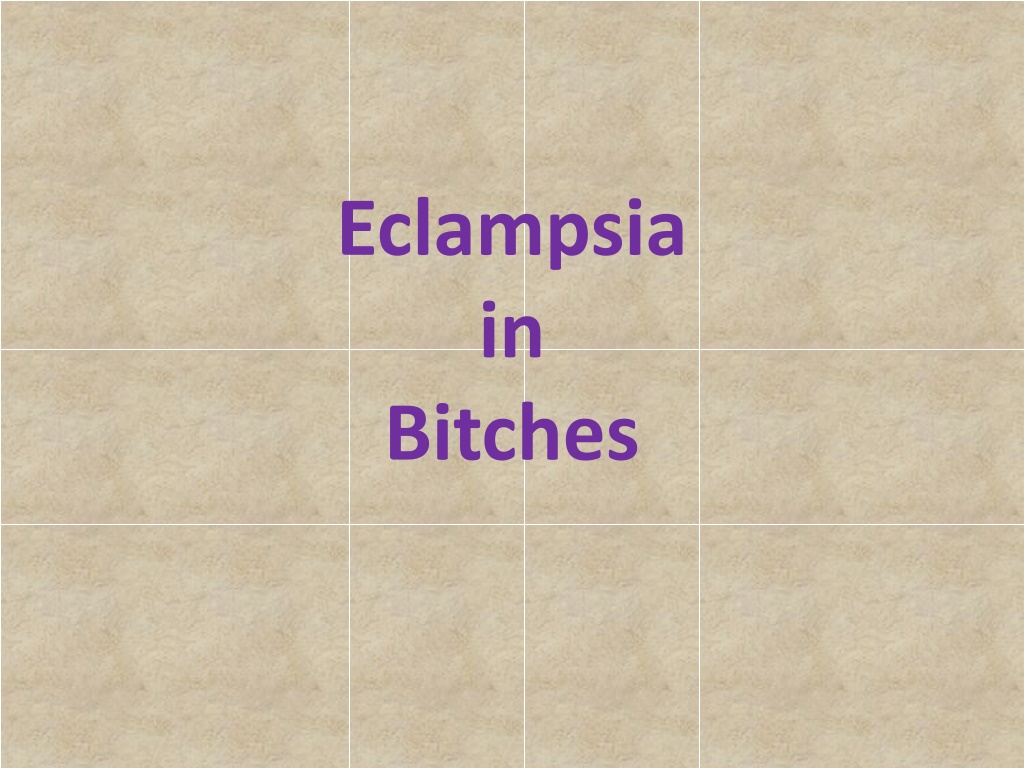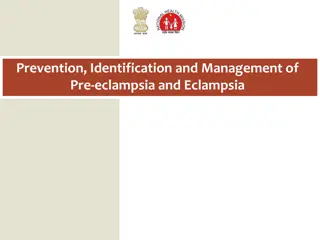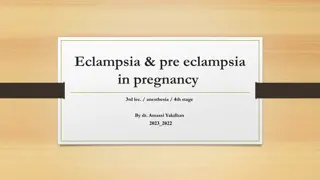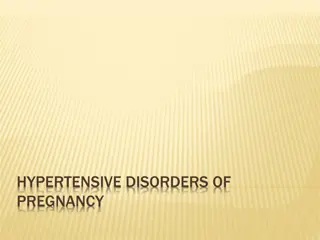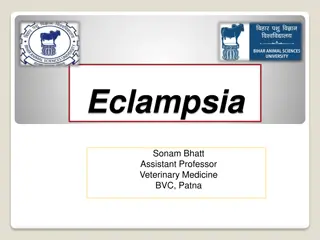Understanding Eclampsia in Bitches: Causes and Symptoms
Eclampsia in bitches, also known as lactation tetany or milk fever, is a condition that can occur in the later stages of pregnancy or during lactation. Common in small breeds like Spitz, this disease presents symptoms such as restlessness, panting, and muscle stiffness. The exact causes are not definitive, but it is associated with hypocalcemia and hypoglycemia. Clinical findings include increased respiratory rate, tonoclonic convulsions, and elevated body temperature. Prompt diagnosis and treatment are crucial to effectively manage this condition in affected dogs.
Download Presentation

Please find below an Image/Link to download the presentation.
The content on the website is provided AS IS for your information and personal use only. It may not be sold, licensed, or shared on other websites without obtaining consent from the author. Download presentation by click this link. If you encounter any issues during the download, it is possible that the publisher has removed the file from their server.
E N D
Presentation Transcript
Eclampsia in Bitches
The condition is also known as Lactation tetany, Puerperal tetany, Post-parturient tetany, Hypocalcaemia, Milk fever in bitches Eclampsia is mostly predominant in bitch, occurring either in the later part of pregnancy or during lactation It is also common in human ladies during pregnancy or after delivery. The names and definition of this condition are still somewhat controversial The name eclampsia is probably incorrect and is borrowed from human medicine because of the somewhat similar symptoms true to eclampsia of pregnancy in woman The disease is characterized by restlessness, excitement, panting, sometime continuous crying of the animal due to pain, nervousness etc. The disease is restricted to small breeds of dogs like Spitz, whereas large breeds of dogs (e.g. GSD) are generally not susceptible
Etiology: The condition occurs mostly within 2 to 10 days after whelping but sometimes in bitches suckling a large litter, after 30 days or more More rarely it occurs during late pregnancy or at the time of whelping It is a very obscure disease and the actual aetiology is not yet established. But some suggestions are given about the aetiology of the disease: If the disease occurs within 2 weeks after parturition, basically the problem is due to hypoglycaemia If the disease occurs later in the lactation period, the problem is mostly due to hypocalcaemia If the diseased bitch is given replacement therapy with calcium and glucose, she responds to treatment It indicates that the disease is accompanied with hypocalcaemia and hypoglycaemia But the factors causing hypocalcaemia and hypoglycaemia are unknown. Actual pathogenesis of the condition is not yet known
Clinical Findings: The condition is accompanied with: There must be a history of the condition having occurred in late pregnancy or early lactation The bitch becomes restless and anorectic The respiratory rate is increased and the tongue hangs out (panting) Stiffness of the joints causing pain and stilted gait Bitch becomes staggery, goes down and suffers from tonoclonic convulsion (violent spasmodic contractions of muscle groups all over the body) In some cases the animal may fall forward, the head is thrown back, the legs are galloping, the animal is frantically excited and cries out Opisthotonus arch develops like in strychnine poisoning but the consciousness of the animal is retained
There is rise in temperature which may go about 103oF and sometimes upto 105o 108oF This is metabolic temperature and occurs due to increased energy production in the muscles during violent muscular spasm There may be heat- prostration (heatstroke, sunstroke, hyperthermia) due to severe increase in temperature In late pregnant and post-parturient animal, the vulva and the mammary glands, are swollen or distended, respectively
Diagnosis: The diagnosis of the condition can be made by: The signs are always observed in nursing bitch or those who are in the later part of pregnancy So, there must be history of late pregnancy, whelping or early lactation Characteristic clinical signs like opisthotonus arch, tonoclonic convulsion, high rise in temperature even upto 108oF, stilted gait etc
While differentiated from: making a diagnosis, eclampsia should be Tetanus: The spasm of the muscles or convulsion observed in eclampsia may be confused with tetanus: In eclampsia tono-clonic convulsions occur i.e. contraction and relaxation of the skeletal muscles occur alternately. But in tetanus, there is tonic convulsion i.e. only contractions of skeletal muscles occur Tetanus is characterised by prolapse of the third eyelid, lock jaw or stiffness of the jaw due to increased spasm of the muscles of the jaw, whereas in eclampsia there is no such clinical findings Calcium therapy to the animal gives response in case of eclampsia while in tetanus, the animal does not respond to calcium therapy
Strychnine poisoning: The opisthotonus arch observed in eclampsia may be confused with strychnine poisoning There must be history of strychnine consumption from nux vomica seed in case of poisoning No history of pregnancy or parturition is noticed in case of strychnine poisoning Cyanosis of the mucous membrane is observed in case of strychnine poisoning The animal suffering from the poisoning does not respond to replacement therapy by calcium
Rabies: (a) There must be history of dog bite The animal shows ascending type of paralysis and profuse salivation
Treatment: Once the condition is diagnosed, the following therapeutic measures should be undertaken: (i) Remove the suckling puppies from bitch at least for 24 hours to reduce the drainage of calcium in milk and the suckling pups should be returned only when the bitch is on full, continuous dosage of calcium and vitamin D (ii) Infuse or supplement calcium in the form of Ca-gluconate or Ca-borogluconate. Ca-borogluconate (25% solution) is the drug of choice It should be administered @ 1 ml/kg body wt. in single dose 50% of the required dose is given intravenously and the rest by either i/m or s/c route If quantity of the drug is more, the s/c route is preferred
(iii) Ca-gluconate powder or any oral preparation of calcium and glucose can be fed orally after the injection of calcium borogluconateSometimes about 10 to 15 ml of 40% glucose should be injected. A multiple vitamin supplement may also be helpful (iv) If phenobarbitone may be slowly administered by i/v route until the dog is sedated there is too much excitement, sodium (v) Cortisone or hydrocortisone have a good effect in addition to the usual therapy. Prednisolone is preferred these days by oral route @ 2.5 mg tab b.i.d. for 3 days for adult bitch, then 1.25 mg b.i.d. for 5 days, and then 1.0 mg b.i.d. for a week (vi) Care should be taken so that the bitch does not suffer from hypocalcaemia or hypoglycaemia during pregnancy or lactation period
